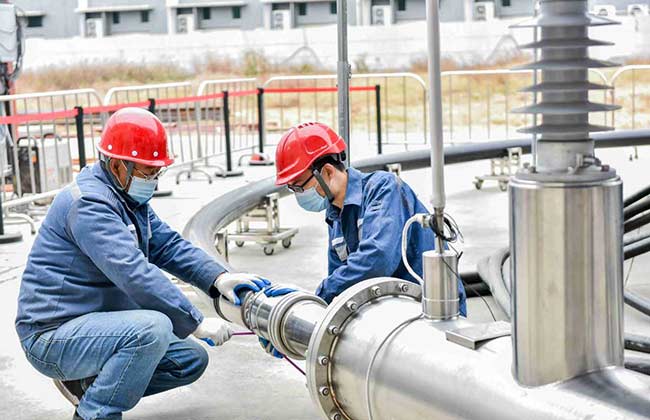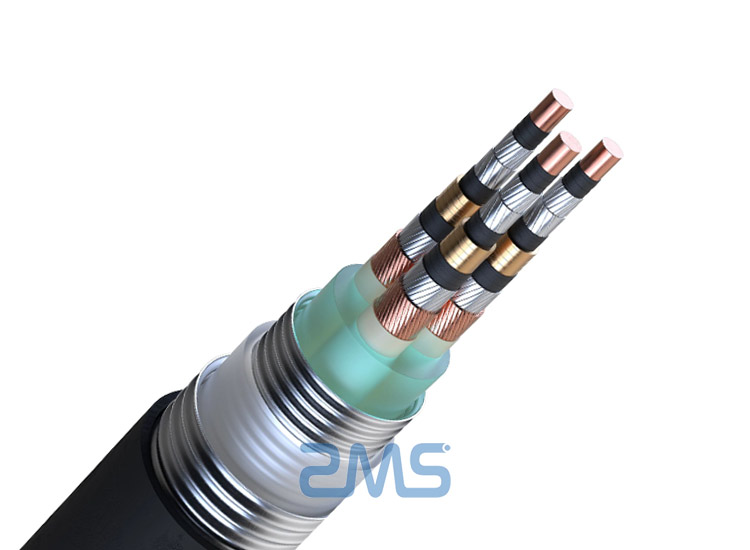State Grid Electric Power Company Conducts a Large Load Test on Superconducting Cables
On July 29, the State Grid Shanghai Electric Power Company organized relevant units belonging to the company to carry out a large-load test of superconducting power cables, which initially verified the ability of superconducting cables to operate with large loads by operating at large loads of more than 1000A for nine consecutive hours and a maximum of 1289A.
On December 22, 2021, the commissioning ceremony of the world’s first 35kV km-level superconducting cable demonstration project, which was independently developed by Shanghai Cable Research Institute for core technology, was held at the construction site in Xuhui District, Shanghai.
The demonstration project line is 1.2km long and is the first superconducting power transmission project built by the State Grid in China. It is the world’s largest transmission capacity, longest length, and full commercial operation of 35kV high-temperature superconducting cable.
As of the end of July this year, the world’s first 35kV km High-Temperature superconductor cable has been in continuous stable operation for more than 7 months, with daily operating load stabilized in the range of 700 to 800A, still with a large margin from the designed maximum 2200A load carrying capacity.
To give full play to the capacity of the superconducting cable system, test the operating status of the superconducting cable during heavy loads and evaluate the energy consumption level of the system, State Grid Shanghai Power carried out this test during the peak load period in the summer.
In the course of the 9-hour test, the High-Temperature superconductor (HTS) cable operating data is normal and stable.
It is understood that in daily operation, the superconducting cable capacity is equivalent to 4 to 5 ordinary cables of the same voltage level, equivalent to 7 to 10 ordinary cables under heavy load operating conditions, which can solve the big city grid “narrow channel large capacity” transmission problems.
To ensure that the test is carried out smoothly, the lead unit, Shanghai South Power Supply Company, has prepared a detailed test plan and risk response measures and refined the content of monitoring parameters and personnel guarding plan.
On the day of the test, on-site special patrol personnel systematically recorded the voltage, current, and power data of the power supply of the superconducting cable cooling system, and obtained the cooling system loss data under a large load through data comparison.
To further improve its operating economy to provide a parameter basis. At the same time, the company’s cable professionals for both sides of the superconducting cable terminals carry out dynamic temperature measurements, collect data on equipment heating under different loads and at different ambient temperatures, and plot the temperature change trend, providing a reference for timely adjustment of the cooling system power.

What is a High-Temperature Superconducting Cable? What are The Advantages of High-Temperature Superconducting Cables?
High-temperature superconducting cable is an electric power facility that uses a non-resistant, superconducting material capable of transmitting high current density as the conductor and capable of transmitting high currents.
With the advantages of small size, lightweight, low loss, and large transmission capacity, it can realize the low loss, high efficiency, and large capacity transmission.
High-temperature superconducting cables will first be used in the short-distance transmission of electricity (such as generators to transformers, substation centers to substations, underground substations to city grid ports) and plating plants, power plants and substations, and another short-distance transmission of large currents, as well as large or super-large urban power transmission occasions.
The transmission loss of high-temperature superconducting cable is only 0.5% of the transmitted power, which is much lower than the 5-8% loss of conventional cables.
In the case of the same weight and size, compared with conventional power cables, the capacity of high-temperature superconducting cables can be increased by 3-5 times and the loss decreased by 60%, which can significantly save floor space and space and precious land resources.
Retrofitting existing underground cable systems with high-temperature superconducting cables can not only increase the transmission capacity by more than 3 times but also reduce the total cost by 20%.
The use of high-temperature superconducting cables can also change the traditional transmission method by using low voltage and high current to transmit electrical energy. Therefore, high-temperature superconducting cables can greatly reduce the losses of the power system and improve the total efficiency of the power system, which has considerable economic benefits.
Advantages of Superconducting Cables
1. High capacity. Superconducting cables of the same cross-section have three to five times the current-carrying capacity of conventional cables.
2. Low loss. Super conducting cables use in the liquid nitrogen vaporization temperature (about -196 ℃) without resistance to transmit large currents, conductor losses of less than one-tenth of conventional cables, plus the energy loss of refrigeration. Its total operating loss is only 50%-60% of the conventional cable.
3. No pollution. Superconducting power cables do not pollute the environment, while oil-filled conventional cables are at risk of oil leakage and environmental pollution.
4. Save materials. A kilogram of hts superconducting cable can complete 77 kg of ordinary cable conduction, greatly saving the amount of traditional copper. The same transmission capacity super conducting cable compared to conventional cables, the use of metal and insulation materials less.
5. The use of hts power cable has low noise and electromagnetic pollution.
6. Small size. Save the transmission system footprint and space, saving a lot of valuable land resources.
7. High safety and reliability, basically eliminating fire hazards.
According to the ZMS cable team, the global market for superconducting applications is forecast to reach $244 billion (about RMB 1,516.4 billion) by the end of 2022, with high-temperature superconducting cables accounting for about 5% of the share. A total of about 130,000 km of existing underground cables worldwide will likely be replaced by high-temperature superconducting power cables one after another. Therefore, the market prospect of high-temperature superconducting cables is very broad.
